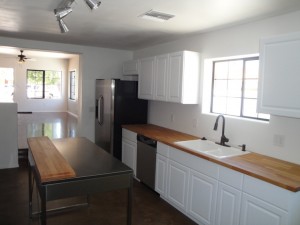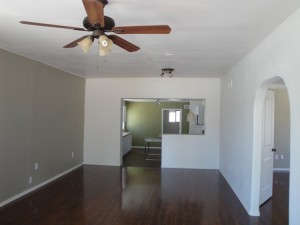 I was very excited when I got invited to an open house by Sunday Studio a couple of weeks ago to check out the eco-flip they did on McKinley and 16th St. in the Garfield Neighborhood. The photo of the end product was gorgeous and it intrigued me. I was duly impressed when I got a tour, it was a house that any downtown resident would be proud to call their home. When I saw the slide-show of the before and after pictures of the house, I knew we had a visionary on our hands, a person who cared about improving our downtown neighborhoods and someone who was doing something about it.
I was very excited when I got invited to an open house by Sunday Studio a couple of weeks ago to check out the eco-flip they did on McKinley and 16th St. in the Garfield Neighborhood. The photo of the end product was gorgeous and it intrigued me. I was duly impressed when I got a tour, it was a house that any downtown resident would be proud to call their home. When I saw the slide-show of the before and after pictures of the house, I knew we had a visionary on our hands, a person who cared about improving our downtown neighborhoods and someone who was doing something about it.
I had a chance to sit down with this person – Brandon Gowen – the owner and principal of Sunday Studio, last Thursday over coffee at Giant. He told me the story of how he got started and how he managed to do such a successful flip in this abysmal real estate market.
Brandon said he was looking for houses for a while and happened to drive by this one and was drawn to it. He wasn’t looking for houses like most people look for houses, searching for the nicest one in the nicest neighborhood they can afford. No, Brandon was looking to make an impact. He was looking for a fixer-upper in an neighborhood that really needed help.
Hard to see, but this house was in awful condition, a real eye sore in the neighborhood, before Brandon got his hands on it
Brandon’s background in architecture lent him the skills necessary not only to visualize the end product, but to execute it as well. His contacts in the construction industry made it easy for him to hire the right help at the right price to get the job done. He was also able to secure the permits necessary to do the renovations himself, using his experience with the Development Services Department and the Historic Preservation Office at the City of Phoenix.
What I love about what Brandon did with this project is that he wasn’t just in it to make a few bucks, like most people who’re into flipping houses are. He wanted to raise the quality of the house by making it as green as he could and as a result he raised the quality of the entire neighborhood. He had a very limited budget as this was his first project and he had scrounged money to do it from friends and family. In fact, he told me that his investors urged him to skip the “green” renovations in order to save money. But Brandon was able to ward off their concerns because he did something very smart: he incorporated the greening of the house into his budget early on, so it wasn’t an add-on that the investors could cut out. The green renovations were integral to the project. This strategy is something so many developers and architects can learn from.
The kitchen and living room are cleanly designed and feel comfortable, warm
Although Brandon was not able to get a LEED for Homes or NAHB certification on the project due to his limited budget, he was able to get an Energy Star rating. He was strategic in the green renovations that he did. The biggest and most important step he took was to weatherize the house, seal it up and add insulation to the attic. He had an energy audit done before and after the project was completed. He said the house was in such bad shape that the blower-door test (testing the air-leakage of a house) did not even get a reading! But after weatherizing the house, Brandon was able to achieve something like a 250% improvement in getting the house sealed.
Another strategy Brandon employed in making the house green, and one that I very much espouse, is reusing what was there and buying recycled products from places like Re-Store and Stardust Building Supplies. Reusing and recycling make for a brilliant green strategy because not only does it save money, but it’s truly a sustainable practice.
This before and after shot of the bathroom gives you an idea of what Brandon started with
A testament to how well Brandon did with the project from the selection of the house to the final execution was that it was sold before it ever hit the market. He got a few interested people stopping in while he was doing the renovations and one turned out to be serious. This person, whom I had the pleasure to meet, was able to see how nice the house would end up being and he put an offer on it. He’s now the happy owner and resident of this beautiful Pueblo-style house.
Looking inside the newly-renovated house (looking good!)
Brandon told me he consulted with his colleague who had a Masters degree in Historic Preservation to determine was was historically appropriate and what wasn’t. I appreciate Brandon’s thoughtfulness behind this and the results speak for themselves. This home was a victim of some pretty terrible additions and cobbled renovations. For example, the whole house was recently clad with flagstone, completely eradicating the clean adobe look of the Pueblo-style house it used to be when it was first built in 1936. Brandon was able to remove the flagstone and re-skin the building with synthetic stucco (something I’m not a big fan of, but it’s very appropriate on this project). He painted the the stairs to the house a desert red, again a reference to the original style of the house. My favorite design feature on the exterior are the pavers Brandon added leading to the entrance. These pavers create the experience of a procession giving the house a grand presence and they connect the house to the street life on McKinley.
Congratulations to Brandon and his team for such a successful and inspiring eco-flip! I look forward to seeing more projects from Sunday Studio. I also would love to see more architects doing projects like these. Their expertise and design sensibilities can bring tremendous value to the rehabilitation of individual houses and entire neighborhoods.
Photo Credit: All photos by Brandon Gowen



























When I look at the original photo of the house, I see a PERSONAL home, something influenced by the homeowner and their unique ideas(weird arch, planters, scruffy landscape). Is this the original and historic look of the house? Not sure, but it screamed character.
The new version is about as sterile as a home can get. It’s Southwest Dwell, not old Phoenix. Maybe the new owners can do something to make it less sterile, but when I see something like this I can only think of http://www.unhappyhipsters.com
Steve, I appreciate your sentiment, but the tacked-on flagstone all over the house, the shoddily-constructed fence and gateway arch plus the bad trailer shed addition isn’t what I call character, but just bad design.
Yes, this clean-looking Pueblo style is the original look of the 1936 house. But even if it weren’t, it’s miles better than what was there before.
“The kitchen and living room are cleanly designed and feel comfortable, warm”….when I saw that picture, I thought icy, not warm.
I completely understand your appreciation for this, but it’s actually a matter of personal taste, the same personal taste decisions that make people attracted to Kitsch instead of Dwell.
When I saw the recent sale of this house (I’m a realtor) I did a double take. I searched up the previous listing to be sure I wasn’t crazy; it really was the mess of a property I remembered for sale earlier in the year. Brandon (who I haven’t met) did an amazing job of turning an absolute eyesore into a beautiful place. I hope other “flippers” are paying attention– rebuild the wrecks, smartly, after consulting with someone who understands historic. Kudos!
Steve, I give you that certain styles are subject to different tastes, but as a design professional, I believe in fundamentally good design vs. fundamentally bad design, and this is something that transcends style. What was there before wasn’t even bad design, design was completely absent from the equation, it was obviously the work of an amateur out of their league and it wasn’t helped by bad craftsmanship.
I’m sure you can understand this from a film perspective, there is good film-making and bad film-making right, regardless of the style.
Maureen, I agree with you, this project is a great example for others like it!
Hmm, how about a film to continue the discussion of taste? Please know I realize the place you are referencing could clearly had some trash and other issues, but here’s a film about an “amateur”who probably could have made his mid-century ranch home into something “professionally” tasteful. It could someday become a redo, someone with an architectural pro might not appreciate his naive and profoundly artistic eye…but I appreciate good art no matter how schooled.
http://www.youtube.com/watch?v=9Cu-__rKSTE
Steve, thank you for sharing that very cool little film! And yes I do appreciate if not the aesthetic of the “garden” but the sheer otaku that it took.